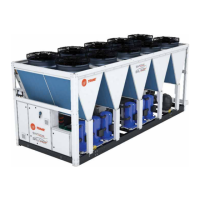72
CG-SVX039C-GB
Unit Start Up Procedures
Daily Unit Start Up
The time line for the sequence of operation begins with a
power-up of the main power to the chiller. The sequence
assumes 2 circuits, 2 compressors, Sintesis air cooled
CGAF chiller with no diagnostics or malfunctioning
components. External events such as the operator
placing the chiller in AUTO or STOP, chilled water flow
through the evaporator, and application of load to the
chilled water loop causing loop water-temperature
increases, are depicted and the chiller responses to those
events are shown, with appropriate delays noted. The
effects of diagnostics, and other external interlocks other
than evaporator water-flow proving, are not considered.
Note: unless the UC800 TD7 and building automation
system are controlling the chilled water pump, the
manual unit start sequence is as follows. Operator
actions are noted.
General
If the present checkout, as discussed above, has been
completed, the unit is ready to start.
1. Press the STOP key on the TD7 display.
2. As necessary, adjust the set point values on the
TD7 menus using Tracer TU.
3. Close the fused-disconnect switch for the chilled-
water pump. Energize the pump(s) to start water
circulation
4. Check the service valves on the discharge line,
suction line, oil line, and liquid line for each circuit.
These valves must be open (back seated) before
starting the compressors.
5. Verify that chilled water pump runs for at least one
minute after the chiller is commanded to stop (for
normal chilled water systems).
6. Press the AUTO key. If the chiller control calls for
cooling, and all safety interlocks are closed, the unit
will start. The compressor(s) will load and unload in
response to the leaving chilled – water temperature.
After the system has been operating for approximately
30 minutes and has become stabilized, complete the
remaining start up procedures, as follows:
1. Check the evaporator refrigerant pressure and the
condenser refrigerant pressure under Refrigerant
Report on the TD7.
2. Check the EXV sight glasses after enough time has
elapsed to stabilize the chiller. The refrigerant flow
through the sight glasses should be clear. Bubbles in
the refrigerant indicate either low refrigerant charge
or excessive pressure drop in the liquid line, or an
expansion valve that is stuck open. A restriction in
the line can sometimes be identified by a noticeable
temperature differential between the two sides of
the restriction. Frost will often form on the line at
this point. Proper refrigerant charges are shown in
the General Information Section.
Seasonal Unit Startup Procedure
1. Close all valves and reinstall the drain plugs in the
evaporator.
2. Service the auxiliary equipment according to the
startup and maintenance instructions provided by
the respective equipment manufacturers.
3. Close the vents in the evaporator chilled water
circuits.
4. Open all the valves in the evaporator chilled water
circuits.
5. Open all refrigerant valves.
6. If the evaporator was previously drained, vent and
fill the evaporator and chilled water circuit. When
all air is removed from the system (including each
pass), install the vent plugs in the evaporator water
boxes.
7. Check the adjustment and operation of each safety
and operating control.
8. Close all disconnect switches.
9. Refer to the sequence for daily unit start up for the
remainder of the seasonal start up.
CAUTION! Ensure that the compressor and heaters
have been operating for a minimum of 24 hours before
starting. Failure to do so may result in equipment
damage.
System Restart After Extended
Shutdown
1. Verify that the liquid-line service valves, compressor
discharge service valves, and optional suction
service valves are open (back seated).
2. Check the oil level (see Maintenance procedures
section).
3. Fill the evaporator water circuit. Vent the system
while it is being filled. Open the vent on the top of
the evaporator while filling, and close it when filling
is completed.
4. Close the fused-disconnect switches that provide
power to the chilled water pump.
5. Start the evaporator water pump and, while water is
circulating, inspect all piping for leakage. Make any
necessary repairs before starting the unit.
6. While the water is circulating, adjust the water flow
and check the water pressure drops through the
evaporator. Refer to “water-system flow rates” and
“water-system pressure drop”.
7. Adjust the flow switch on the evaporator piping for
proper operation.
8. Stop the water pump. The unit is now ready for
startup as described “Startup procedures”.

